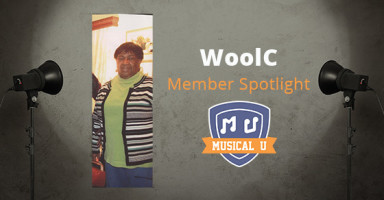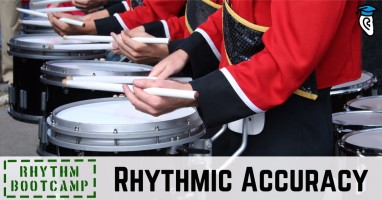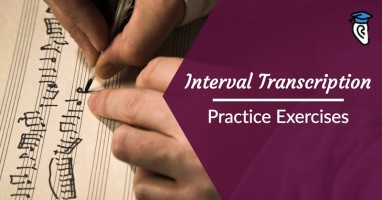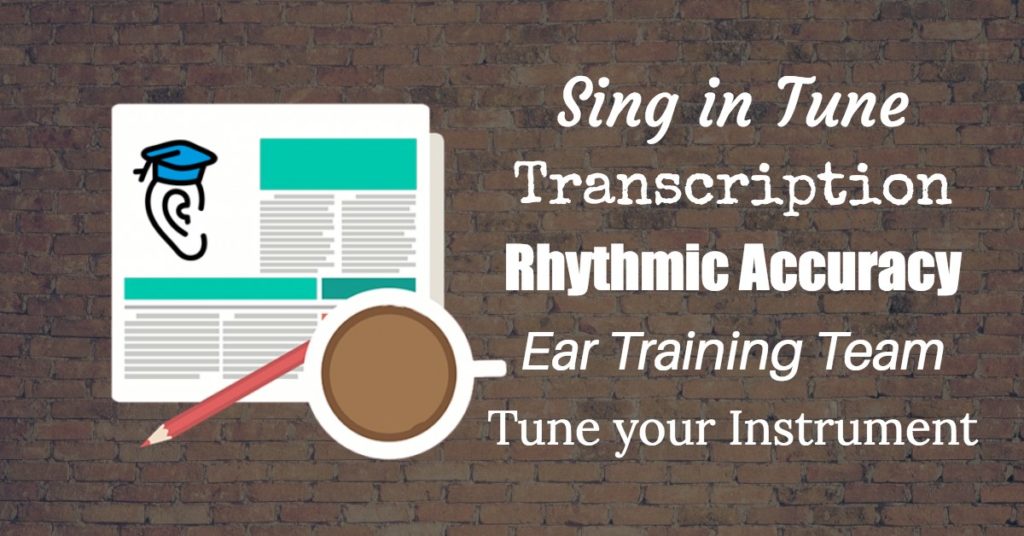In music there are so many new skills to learn as well as scope to improve your existing abilities, it can be difficult to know where to start. This week we talk about building your own ear training team to help you achieve your ear training goals and speak to a member of the Musical U community to find out how the team at Musical U have helped her reach her full potential as a musician.
Also this week: tips on how to sing in tune, gain rhythmic accuracy, learn to tune your instrument by ear and how to transcribe music using intervals!
Sing in Tune
 At Easy Ear Training we often come across people who are worried they can’t sing or have been told they are “tone deaf”. However there in fact are very few people who truly cannot sing in tune – everyone else just hasn’t learned this skill yet!
At Easy Ear Training we often come across people who are worried they can’t sing or have been told they are “tone deaf”. However there in fact are very few people who truly cannot sing in tune – everyone else just hasn’t learned this skill yet!
If you are ready to warm up your vocal chords and sing get some tips here: 11 Tips to Help the “Tone Deaf” Sing in Tune. Don’t forget to share the link with your friends and family members who you think could do with some singing encouragement too.
Feeling skeptical that your “tone deafness” can even be helped? Take a look at this inspiring video from sensational singing instructor Per Bristow, or go see the new movie Marguerite based on the story of Florence Foster Jenkins, a real-life famous tone-deaf opera singer.
Musicality means… Tuning your Instrument by Ear
 While we are on the topic of being in tune, how do you tune your instrument? If you rely on an electric tuner then when you see someone tune up entirely by ear, it probably seems like they’re impressively musical. Along with singing in tune, improving your sense of pitch so that you can tune your instrument by ear is a skill you can learn. It can also benefit your musicianship in several other ways too. Find out more in Musicality means… Tuning your Instrument by Ear.
While we are on the topic of being in tune, how do you tune your instrument? If you rely on an electric tuner then when you see someone tune up entirely by ear, it probably seems like they’re impressively musical. Along with singing in tune, improving your sense of pitch so that you can tune your instrument by ear is a skill you can learn. It can also benefit your musicianship in several other ways too. Find out more in Musicality means… Tuning your Instrument by Ear.
For a general perspective on musicality here’s a great guide from Strings Magazine, written for cello but with lessons for us all. And did you know that musicality even reaches as far as speech?
Who’s on your Ear Training Team?
 When you embark on a new quest it’s important to have a team around you. Ear training is no different, yet many of us try to do it alone. That can work for a while but it is common to become bored, stuck or frustrated and let your ear training fizzle out. Read on to find out how to assemble your very own ear training team: the first step to achieving your ear training goals in a fun, effective and efficient way!
When you embark on a new quest it’s important to have a team around you. Ear training is no different, yet many of us try to do it alone. That can work for a while but it is common to become bored, stuck or frustrated and let your ear training fizzle out. Read on to find out how to assemble your very own ear training team: the first step to achieving your ear training goals in a fun, effective and efficient way!
Learn more about ear training with others in this informative tutorial from SmartMusic.com and this insightful piece on getting on well with other musicians from GuitarNoise.com.
Musical U Member Spotlight
 Joining Musical U is one way to find the three components of an ear training team all in one place. For an example, check out this week’s Member Spotlight with user WoolC. Having played piano all her life she describes how her lack of listening skills was holding her back. Being part of the Musical U community has resulted in music becoming her main focus and has been having a positive affect on all parts of her life.
Joining Musical U is one way to find the three components of an ear training team all in one place. For an example, check out this week’s Member Spotlight with user WoolC. Having played piano all her life she describes how her lack of listening skills was holding her back. Being part of the Musical U community has resulted in music becoming her main focus and has been having a positive affect on all parts of her life.
Rhythmic Accuracy
 Have you ever felt yourself rushing or dragging during a performance? This is a common problem even the most seasoned musicians have, so don’t worry – we can help! The third tutorial in the Rhythm Bootcamp series is all about rhythmic accuracy. Find out the three causes of rhythmic inaccuracy and then learn how to tackle them. Then test what you have learned with the rhythmic accuracy practice exercise.
Have you ever felt yourself rushing or dragging during a performance? This is a common problem even the most seasoned musicians have, so don’t worry – we can help! The third tutorial in the Rhythm Bootcamp series is all about rhythmic accuracy. Find out the three causes of rhythmic inaccuracy and then learn how to tackle them. Then test what you have learned with the rhythmic accuracy practice exercise.
Looking for more rhythm training tips? Check out this great post from Ninebuzz.com with 10 Tips for More Effective Rhythm Training.
And if your rhythm accuracy still isn’t up to scratch after Rhythm Bootcamp, maybe you just need a robot arm?
Interval Transcription
 Understanding, recognising and being able to spell intervals is the gateway to being able to do many things in music including transcribing. It takes a bit of time and practice to be able to transcribe accurately which is why we have created some free Interval Transcription Practice Exercises to help you along.
Understanding, recognising and being able to spell intervals is the gateway to being able to do many things in music including transcribing. It takes a bit of time and practice to be able to transcribe accurately which is why we have created some free Interval Transcription Practice Exercises to help you along.
Looking for more? Here’s a short and sweet tutorial from TakeLessons.com about transcribing a song’s melody using intervals and singing, and a more in-depth transcription tutorial from JazzAdvice.
I hope you are now convinced that progressing in music is much easier with a team! With that in mind don’t forget to check out the Easy Ear Training and Musical U Facebook pages for all our latest resources and musical motivation so that we can help you keep improving.







